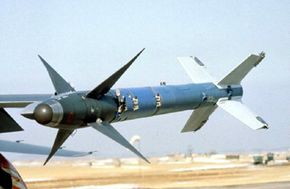Smart Weapons
The Sidewinder AIM-9 (air intercept missile 9) is classified as a short-range, air-to-air missile. Simply put, its job is to launch from an airborne aircraft and "kill" an enemy aircraft (damage it to the point that it goes down). Missiles like the Sidewinder are called smart weapons because they have built-in seeking systems that let them home in on a target.
The technology of smart weapons really got going in the decade following World War II. Most early guided weapon prototypes were built around radar technology, which proved to be expensive and problematic. These missiles had their own radar sensors, but obviously could not carry their own radar transmitters. For the guidance system to lock on an enemy plane, some remote radar system had to "illuminate" the target by bouncing radar beams off of it. In most cases, this meant the pilot had to keep the aircraft in a vulnerable position after firing in order to keep a radar lock on the enemy until the missile could find it. Additionally, the radar equipment in the missile was large and expensive, which made for a high-cost, bulky weapon. Most of these missiles had something around a 90 percent failure rate (nine shots out of 10 missed their targets).
Advertisement
In the next section, we'll see how this failure rate was addressed in the building of a new targeting system.
